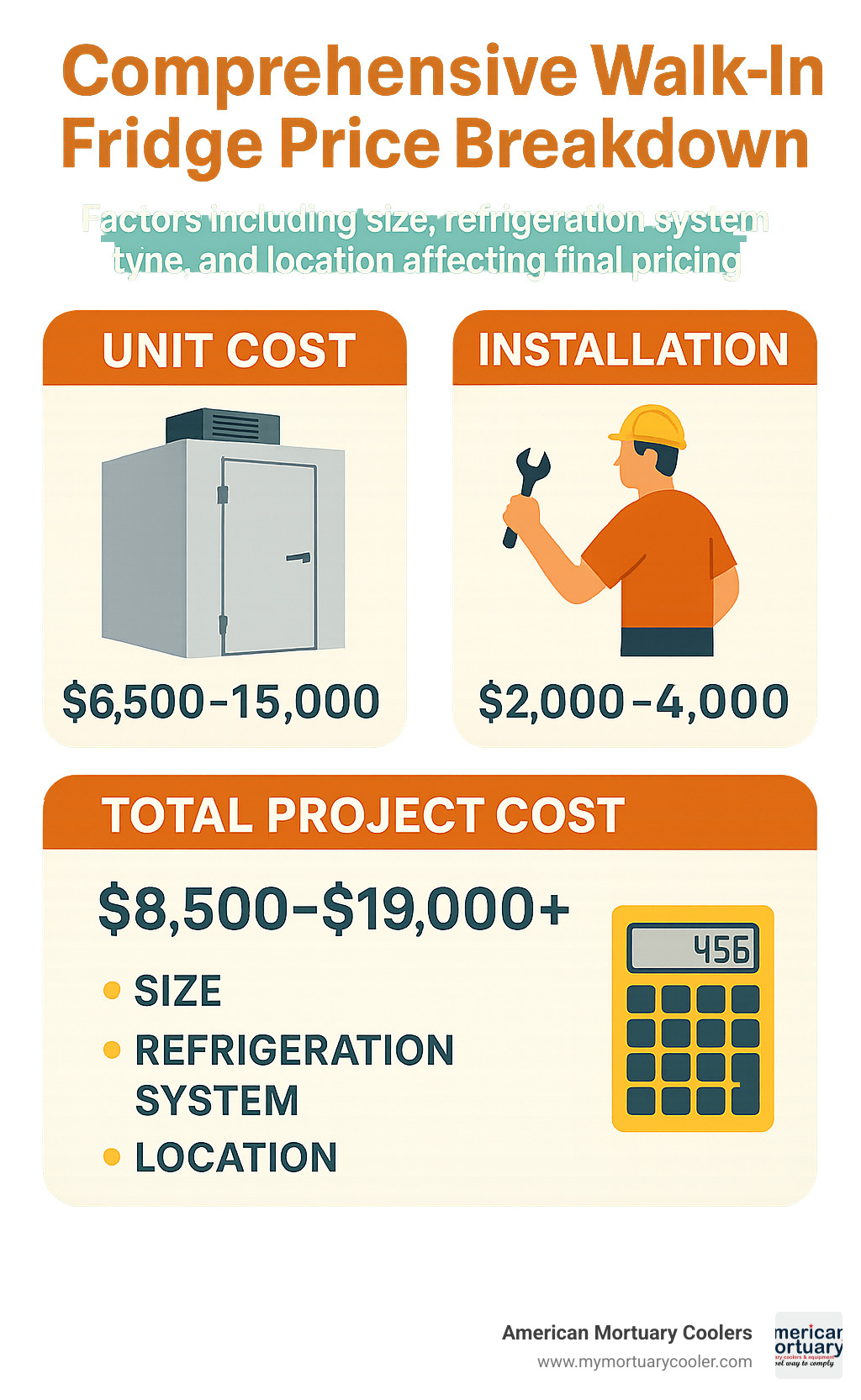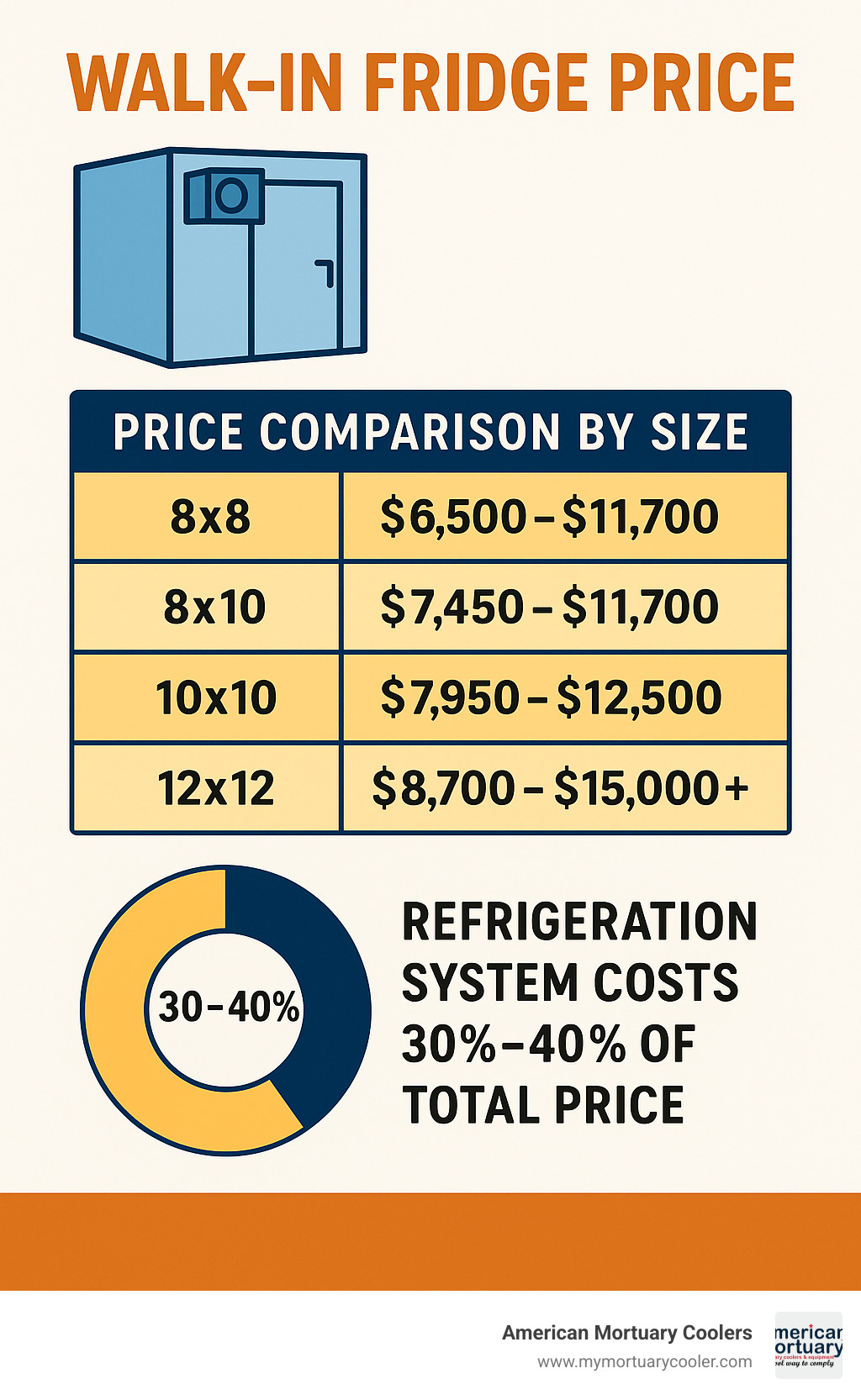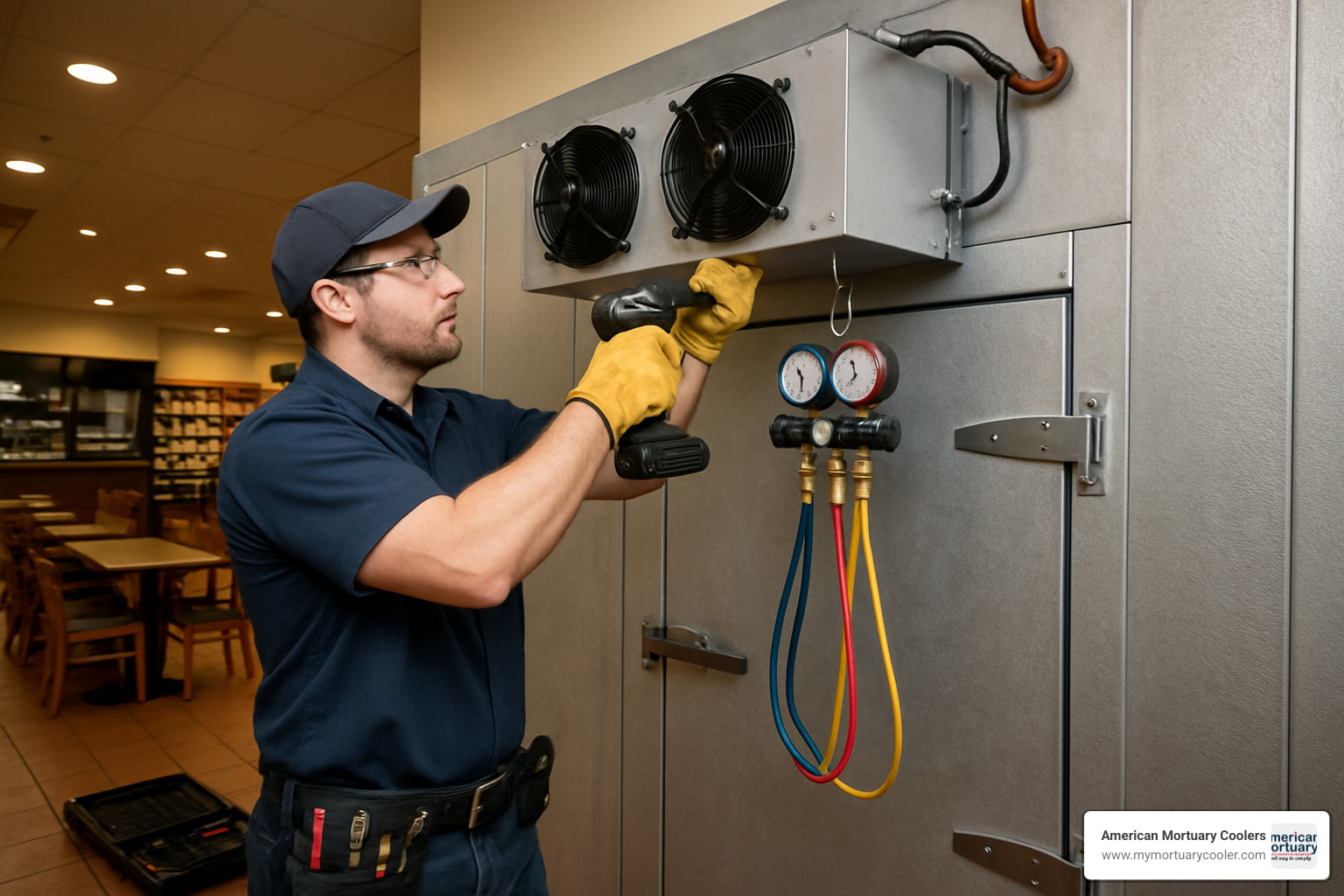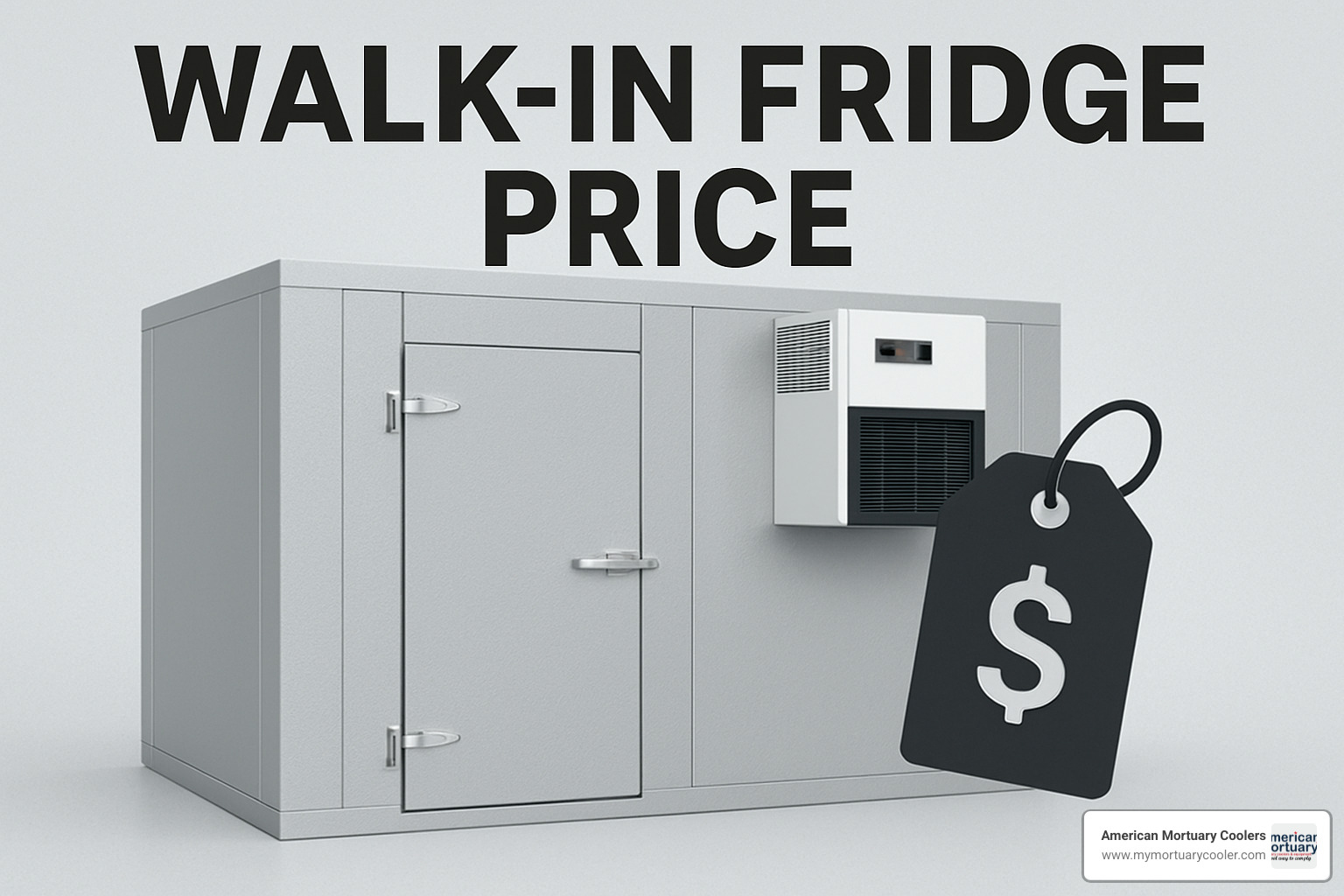Why Understanding walk in fridge price Matters for Your Business
Walk in fridge price varies dramatically based on size, features, and installation requirements, making it essential to understand all cost factors before making this significant investment. Whether you're outfitting a restaurant kitchen, funeral home, or medical facility, a walk-in cooler represents one of your largest equipment purchases.
Quick Price Overview:
- Small units (8x8): $6,500 - $11,700
- Medium units (8x10 to 10x10): $7,950 - $12,500
- Large units (12x12): $8,700 - $15,000+
- Installation costs: $2,000 - $4,000 additional
- Total project cost: $8,500 - $19,000+ depending on complexity
The research shows that the average walk-in cooler costs about $15,000, with custom units ranging from $10,000 to $40,000. However, standard quick-ship models offer more budget-friendly options at $8,000 to $30,000.
Several factors drive these price differences. Size is the primary factor - a basic 7'8" x 7'8" unit starts around $6,500, while a 12' x 12' model costs $8,700 or more. The refrigeration system alone accounts for 30-40% of the total cost, and choosing between self-contained versus remote systems significantly impacts your budget.
Installation adds another layer of complexity. Professional installation typically costs $2,000 to $4,000, but can reach $9,000+ in expensive markets like New York. Permits, electrical upgrades, and site preparation can push total project costs well beyond the equipment price.
I'm Mortuary Cooler, a national-level mortuary cooler supplier with extensive experience helping businesses steer walk in fridge price considerations and find the right cold storage solutions. My background includes working with funeral homes, restaurants, and medical facilities to identify cost-effective options that meet their specific operational needs.

Walk in fridge price terms at a glance:
What Is a Walk-In Fridge & Who Needs One?
Think of a walk-in fridge (also called a walk-in cooler) as your regular refrigerator's much bigger sibling - one that's actually large enough to walk inside. Instead of cramming everything into a few cubic feet, you get hundreds of cubic feet of cold storage space that you can organize, access easily, and actually move around in.
These commercial-grade units maintain temperatures between 28°F and 55°F, though the FDA requires commercial units to stay at 41°F or lower for food safety. Most businesses find that 38°F hits the sweet spot - cold enough to preserve everything properly without accidentally freezing delicate items.
Now, you might wonder who actually needs all this cold storage space. The answer might surprise you - it's not just restaurants. Restaurants and food service operations are the obvious candidates, especially since a typical 50-seat restaurant needs about 75-100 cubic feet of walk-in storage just to handle daily operations efficiently.
Funeral homes and mortuaries represent another major market, requiring specialized temperature control for their sensitive needs. At American Mortuary Coolers, we've spent years perfecting custom mortuary coolers that meet the unique requirements of the funeral industry.
Medical facilities depend on walk-in coolers for pharmaceuticals, lab specimens, and temperature-sensitive medical supplies. Florists use them to keep cut flowers fresh and extend the life of arrangements. Breweries and beverage distributors need the space for kegs, bottles, and ingredients that must stay cool.
Even convenience stores are finding that walk-in coolers can dramatically expand their cold storage beyond what traditional reach-in coolers can provide.
The real beauty of walk-in refrigeration lies in its efficiency. Instead of juggling multiple smaller units, you get one organized space that's more energy-efficient per cubic foot and makes inventory management so much easier. When you're considering walk in fridge price, you're investing in a solution that can replace several smaller units while giving you room to grow.
More info about walk-in cooler features
Key Components & How They Work
Understanding what goes into a walk-in cooler helps explain why walk in fridge price can vary so dramatically between units that look similar on the surface.
Insulated panels form the foundation of your cooler - literally. These aren't just regular walls with some insulation thrown in. We're talking about 4-inch thick panels filled with foamed-in-place urethane insulation that achieves R-values of R-29 for coolers and R-32 for freezers. Quality panels typically come with 10-20 year warranties because they're built to last. The better the insulation, the less your refrigeration system has to work, which saves you money every month on your electric bill.
Door hardware might seem like a small detail, but it's crucial for maintaining temperature and ensuring safety. Commercial-grade doors feature heavy-duty hinges that won't sag over time, magnetic gasket seals that create an airtight closure, and interior safety releases (because nobody wants to get locked inside). Many doors include self-closing mechanisms and keyed locks. These upgrades can add 10-15% to your total cost, but they're worth it for the peace of mind and energy savings.
The refrigeration unit is where 30-40% of your budget goes, and for good reason. The compressor, evaporator, and condenser work as a team to maintain your set temperature. The system kicks on when temperature rises above your setpoint (usually 38°F) and shuts off once it's reached. Modern units include a defrost cycle that prevents ice buildup when temperatures drop below 35°F.
Control systems have come a long way from simple dial thermostats. Today's units feature digital controls, LED temperature displays, and alarm systems that alert you if something goes wrong. Some even have microcontroller-based staging that manages multiple compressors for optimal efficiency.
Typical Configurations (Indoor/Outdoor, Floor/No Floor)
Walk-in coolers come in several configurations, and your choice here significantly impacts both walk in fridge price and installation complexity.
Indoor units are the standard choice, designed to fit inside your existing building. Outdoor units need weather-resistant packages that add 10-15% to the cost, but they're perfect if you don't have interior space or want to avoid structural modifications to your building. Some businesses love outdoor units because they free up valuable indoor real estate.
The floor versus no floor decision is a big one financially. Units with integrated insulated floors cost 10-20% more, but they provide better temperature control and make cleaning much easier. If you have a suitable concrete pad that's level, properly drained, and can support 600-1,200 pounds per square foot, you can skip the floor and save money.
Size configurations typically include standard dimensions like 8x8, 8x10, 8x12, 10x10, and 12x12 feet. Custom sizes are available but usually cost more and have longer lead times. Here's a helpful tip: when calculating your usable interior space, subtract 8 inches from both length and depth to account for the 4-inch wall thickness on each side. That 8x8 unit actually gives you about 7x7 feet of interior space.
walk in fridge price: Factors, Sizes & Typical Ranges
When you're ready to invest in a walk-in cooler, understanding walk in fridge price becomes crucial for making the right decision. The numbers can seem overwhelming at first, but once you break down the components, the pricing structure makes perfect sense.

Based on current market data, here's what you'll actually pay for different sizes. A 7'8" x 7'8" unit starts at $6,498.83 for the basic box. Moving up to an 8' x 10' cooler costs $11,709, but this includes the refrigeration system - that's why the jump seems so dramatic.
The 8' x 12' models run about $12,497 with refrigeration included, while a 10' x 10' unit starts at $7,956.87. For larger operations, 12' x 12' coolers begin at $8,695.80. These prices include shipping to the contiguous 48 states, which is exactly where we at American Mortuary Coolers provide our direct delivery service.
Here's the key insight: the refrigeration system accounts for 30-40% of your total walk in fridge price. A basic half-horsepower system adds about $500, but larger units need more powerful refrigeration that can cost several thousand dollars. This is why some quotes seem to jump dramatically between similar-sized units.
The choice between remote versus self-contained refrigeration also significantly impacts your budget. Self-contained units put everything in one package, making installation simpler and costs more predictable. Remote systems split the condenser from the evaporator, which works better in hot climates but requires professional refrigeration line installation.
→ Free Download: The Ultimate Guide to Buying a Walk in Cooler in 2023 [Access Now]
Size & Configuration: How walk in fridge price Scales
Understanding how walk in fridge price scales with size helps you make smarter decisions. The good news is that costs don't increase linearly - you get better value as you go bigger, but there are some quirks in the pricing.
When you break down the cost per square foot, interesting patterns emerge. That small 64 square foot unit costs about $101.54 per square foot. The 81 square foot model jumps to $144.56 per square foot, but remember - this includes refrigeration. The 95 square foot unit drops back to $131.55 per square foot, while the 100 square foot model offers excellent value at just $79.57 per square foot.
The 144 square foot unit provides the best economy at $60.39 per square foot. These variations happen because some quotes include refrigeration while others don't. Always ask what's included when comparing prices.
Door options also affect your final cost. Standard swing doors come with the base price, but upgrading to wider 49-inch doors for pallet access costs extra. Glass doors for retail display applications add significant expense but might be worth it if customers can see your fresh products.
Configuration choices can save you money without sacrificing functionality. Skipping the insulated floor saves 10-20% if you have a suitable concrete pad. Choosing a cooler-freezer combo unit saves 10-15% compared to buying separate units. Adding an outdoor weather package costs 10-15% more but eliminates expensive building modifications.
Standard vs Custom: Decoding walk in fridge price
The standard versus custom decision dramatically affects your walk in fridge price and timeline. Most businesses can save money and time by choosing quick-ship models, but sometimes custom is the only way to get what you need.
Quick-ship models cost $8,000 to $30,000 and arrive in just 1-6 weeks. These units come in standard sizes with proven configurations, limited customization options, and represent the best value for typical applications. If a standard size fits your space and needs, this is usually your smartest choice.
Custom units range from $10,000 to $40,000 or more, with lead times of 10-12 weeks. You can get any size or configuration, special finishes, and unique features. We typically recommend custom units only when standard sizes won't fit your space or you need special features like mortuary-specific configurations.
Finish upgrades can add 10-40% to your cost, depending on what you choose. The standard 26-gauge galvanized steel with polymer coating works great for most applications. Stainless steel or special coatings cost more but handle corrosive environments better. Premium architectural finishes look beautiful in customer-facing areas but come with premium prices.
Refrigeration System Impact on Budget
Since refrigeration represents 30-40% of your walk in fridge price, understanding your options helps you make the right choice for your situation and budget.
Self-contained systems are the most popular choice because they put all components in one package. Installation is straightforward, costs are predictable, and they work great in moderate climates. Most indoor applications do well with self-contained units.
Remote systems split the condenser from the evaporator, typically mounting the condenser on your roof or outside. They cost more to install because you need professional refrigeration line installation, but they work better in hot environments and run quieter inside your building. The higher upfront cost often pays off through better efficiency and longer equipment life.
Energy efficiency matters more than you might think. A typical 10x10 cooler uses only 0.1529 kWh per day when properly sized and maintained. However, older or poorly maintained units can consume much more energy, making efficiency a key factor in your long-term operating costs.
Beyond the Box: Installation, Energy & Lifetime Costs

The equipment quote is only part of the story—installation, energy and upkeep can add 20-40 % to your overall walk in fridge price. Planning for these costs up front prevents unpleasant surprises later.
Professional installation usually ranges $2,000–$4,000 for a simple indoor setup. Electrical upgrades ($500–$2,000), permits ($100–$500) and basic site prep ($500–$2,000) are extra. In high-cost markets the total can approach $9,000, while lower-cost regions often come in closer to $5,500.
More info about walk-in cooler installation
Site Prep & Professional Installation
This is not a DIY job. Licensed HVAC and electrical pros are mandatory because you’re dealing with 208-230 V power, refrigerant lines and large insulated panels. If you skip an insulated floor, be sure your concrete pad is level (within 1⁄4 in.), has a vapor barrier and drains properly. The assembled box will impose 600–1,200 lb per sq ft, so verify your slab rating before delivery.
Operating Costs & Maintenance
A properly sized 10 × 10 cooler uses around 0.15 kWh per day—often less than a household refrigerator. Monthly tasks like wiping condenser coils and checking door gaskets keep that number low. Schedule a professional tune-up each year to catch small issues before they become $1,000-plus compressor failures.
Typical repair costs:
- Door gasket: $100-$300
- Control board: $200-$800
- Compressor: $1,000-$3,000
Regular maintenance stretches service life to 15–20 years; neglected units may fail in half that time.
Warranty & Code Compliance
Top manufacturers offer 10–20 year panel warranties, 5 years on doors/floors and 5 years on compressors, with 1 year parts & labor. Make sure the unit carries NSF/ANSI 7, UL and current DOE certifications—your health inspector will check.
Whether we’re delivering to Tennessee, California or New York, American Mortuary Coolers verifies every order meets all relevant codes so you can pass inspection the first time.
Smart Shopping: New vs Used, Money-Saving Tips & FAQs

Smart walk in fridge price decisions go beyond finding the lowest sticker price. After helping hundreds of businesses steer this purchase, I've learned that the cheapest option upfront often becomes the most expensive over time.
The used equipment market can look tempting when you're watching every dollar. But here's what I tell my customers: buying a walk-in cooler is like buying a car for your business. You want something reliable that won't leave you stranded when you need it most.
More info about pricing factors
New vs Used: Risks & Rewards
Used walk-in coolers typically cost 30-50% less than new units, which sounds great until you factor in the hidden costs. I've seen too many businesses learn this lesson the hard way.
The biggest problem with used equipment is you never know its maintenance history. That "great deal" might have been sitting in a flooded warehouse or running with dirty coils for years. Refrigeration systems are like engines - abuse them early, and they'll give you trouble for life.
Obsolete refrigerants create another expensive surprise. Older units might use R-22 refrigerant, which is being phased out and costs a fortune to service. Converting to modern refrigerants can cost thousands, wiping out your initial savings.
Then there's the warranty issue. New units come with 10-20 year panel warranties and comprehensive coverage on components. Used units? You're on your own from day one.
Used equipment makes sense in limited situations. If you need temporary storage for a special event or you're testing a new location, a quality used unit from a reputable refurbisher might work. But for your main business operations, the risks usually outweigh the savings.
Depreciation hits walk-in coolers hard in the first few years, just like vehicles. A three-year-old unit might cost 40% less but still have 70% of its useful life remaining. However, finding these "sweet spot" units is challenging, and they often need immediate repairs.
Saving Money Without Sacrificing Safety
Let me share some proven ways to reduce your walk in fridge price without gambling on used equipment.
Skipping the insulated floor saves 10-20% and works perfectly if you have a good concrete pad. Just make sure it's level, properly drained, and has a vapor barrier. Many of our restaurant customers choose this option and never regret it.
Combo cooler-freezer units offer another smart savings opportunity. You'll save 10-15% compared to buying separate units, though you'll need to plan your layout carefully. These work great for smaller operations that need both temperature ranges.
Outdoor installation might sound counterintuitive for saving money since the weather package adds 10-15% to equipment cost. But if your building would need expensive modifications for indoor installation, outdoor can be much cheaper overall.
Utility rebates are free money that many businesses overlook. Energy companies often offer substantial rebates for efficient equipment. Check with your utility before ordering - some rebates require pre-approval.
Financing options can make a higher-quality unit affordable while preserving your cash flow. Many suppliers offer competitive rates, and the monthly payments are often less than what you'd spend on repairs with a cheaper unit.
Frequently Asked Questions (FAQ)
What's the typical lead time to receive a walk-in fridge?
Quick-ship models arrive in 1-6 weeks, which covers most standard sizes and configurations. These units are manufactured in common sizes and stored in regional warehouses for faster delivery.
Custom units take 10-12 weeks because they're built to your exact specifications. This includes unusual sizes, special finishes, or unique configurations like our mortuary-specific units.
At American Mortuary Coolers, we maintain inventory of popular sizes to minimize wait times for our customers. We understand that when you need cold storage, you usually need it soon.
How big should my walk-in be for a 50-seat restaurant?
The rule of thumb is 1.5-2 cubic feet per seat for restaurant applications. This means a 50-seat restaurant needs 75-100 cubic feet minimum of walk-in storage.
In practical terms, this translates to an 8x10 or 10x10 unit depending on your specific needs. Consider your menu complexity, delivery frequency, and growth plans when making this decision.
A pizza place with simple ingredients might get by with the lower end of this range, while a full-service restaurant with complex menu prep needs the higher end. Also factor in whether you'll use the space for beverages, which take up significant volume.
Are used walk-ins worth it?
For short-term needs or severe budget constraints, used equipment can work. But for most businesses, the answer is no.
The math rarely works out when you factor in repair risks, lack of warranty, and potential downtime costs. A restaurant losing product during a busy weekend because their used cooler failed will quickly spend more than they saved.
Better alternatives include financing new equipment, which spreads the cost over time while giving you warranty protection. Leasing options work well for businesses with uncertain long-term needs. You might also consider starting with a smaller new unit and expanding later as your business grows.
The peace of mind that comes with new equipment and full warranty coverage is worth the extra cost for most businesses. Your walk-in cooler needs to work reliably for 15-20 years - it's worth investing in quality from the start.
Conclusion
Making the right walk in fridge price decision means looking at the complete picture, not just that initial number on the quote. You might find a basic 8x8 unit starting around $6,500, but your real investment will likely land somewhere between $8,500 and $19,000+ once you factor in installation, electrical work, and all those little extras that add up.
Here's what really drives your costs: size matters most (obviously), but the refrigeration system is your biggest single expense at 30-40% of your budget. Installation requirements can vary wildly depending on where you are - what costs $5,577 in Denver might run you over $9,600 in New York. Custom features are nice, but standard quick-ship models deliver excellent value for most businesses.
After helping countless businesses across Tennessee, Georgia, Illinois, South Carolina, Texas, California, New York, and Pennsylvania steer these waters, we've learned a few things at American Mortuary Coolers. The businesses that make the smartest decisions think long-term. They buy quality equipment from day one, size for growth, and plan for professional installation and maintenance.
What we always tell our customers: Don't chase the cheapest upfront price if it means compromising on reliability. Whether you're storing ingredients for a busy restaurant or maintaining proper conditions in a funeral home, your walk-in cooler needs to work perfectly, every single day. That's especially true in our mortuary applications, where there's simply no room for equipment failure.
Buy new equipment from manufacturers who stand behind their products. Size appropriately - your current needs plus about 20% for growth. Invest in quality refrigeration because that's the heart of your system. Plan for professional installation because this isn't a weekend DIY project. And always consider lifecycle costs - energy efficiency, maintenance requirements, and warranty coverage matter more than saving a few hundred dollars upfront.
The right walk-in cooler becomes part of your business infrastructure for decades. We've seen units still running strong after 20+ years when they're properly maintained. That's the kind of return on investment that makes the initial walk in fridge price seem like a bargain.
Our direct delivery service across the contiguous 48 states means you get support from the moment you place your order through final installation and beyond. Whether you need a standard commercial cooler or one of our specialized mortuary units, we're here to help you make the decision that's right for your business and your budget.
















